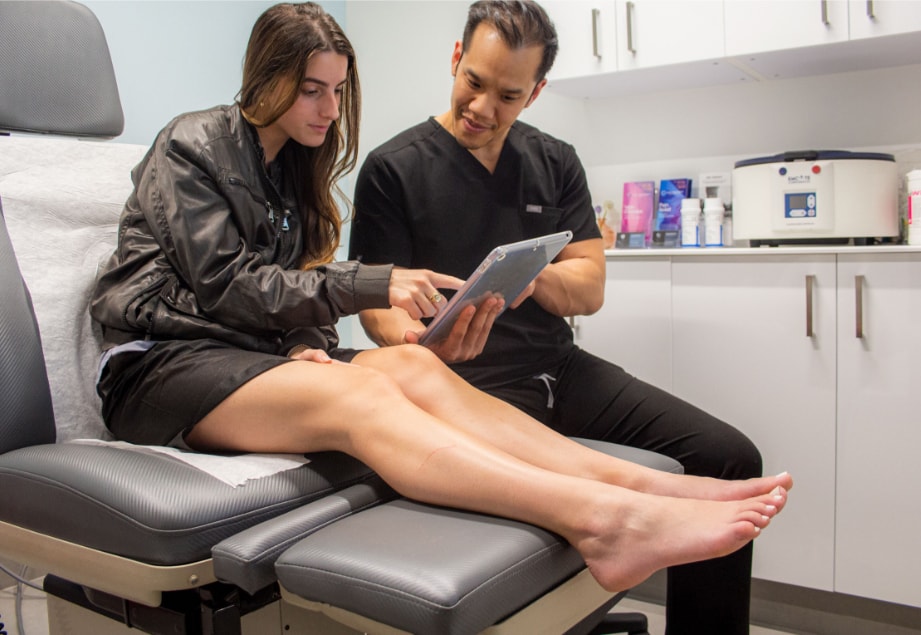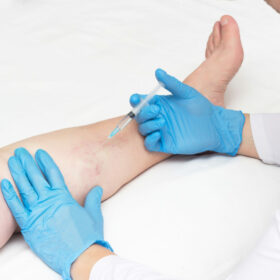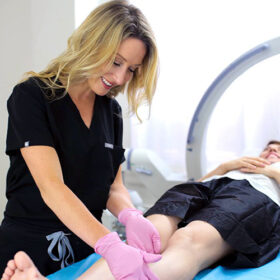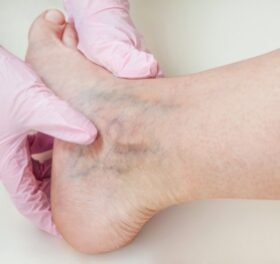What is chronic venous insufficiency?
When patients are told they have chronic venous insufficiency, their first question is often, “can venous insufficiency be cured?” The answer is a little complex. While chronic venous insufficiency can’t be “cured,” it can be treated. But to understand the specific details of chronic venous insufficiency treatments, you should have a good understanding of this condition. This article provides a comprehensive overview of chronic venous insufficiency, answering all the questions you may have about this circulatory disorder.
Let’s start with the most basic question — what is chronic venous insufficiency?
Chronic venous insufficiency is a medical condition wherein your vein valves collapse, and blood accumulates in the leg veins. Healthy veins contain valves that act as one-way doors — they allow blood to flow towards the heart, but they prevent blood from flowing backward because of gravity. When your vein valves malfunction or collapse, blood flows backward and accumulates in the leg veins, leading to dilated veins and protruding blood vessels.
The continued accumulation of blood in leg veins because of gravity leads to vascular dilation. Over time, the leg veins start bulging outwards, leading to spider veins, reticular veins, and varicose veins. Most people are familiar with the most common signs of vein disease — spider veins and varicose veins. But chronic venous insufficiency can also lead to numerous other symptoms, such as restless leg syndrome, leg heaviness, leg pain, and muscle cramps.
What are the stages of varicose veins?
Venous insufficiency is a chronic condition, which means it progressively worsens with time. Varicose veins usually occur in the latter stages of vein disease, i.e., when considerable blood has accumulated in the leg veins, leading to externally bulging veins.
During the initial stage, chronic venous insufficiency leads to extremely mild signs and symptoms, such as restless leg syndrome, leg pain, leg swelling, leg heaviness, skin discoloration, and fatigue. You may eventually notice spider veins on your legs — spider veins are dense clusters of red or bluish blood vessels that appear just underneath the skin’s surface. Spider veins don’t bulge out of the skin’s surface, unlike varicose veins.
As blood continues accumulating in the leg veins, you may move to the latter stages of vein disease. The appearance of varicose veins is the first indication that you have advanced chronic venous insufficiency. Varicose veins are extremely dilated blood vessels that bulge out of the skin’s surface, looking like a twisted, tangled, and knotted mass of ropes. In addition to varicose veins, you may also experience leg ulcers and deep vein thrombosis.
Do men get varicose veins?
One of the most common (and dangerous) misconceptions about vein disease is that men are somehow impervious to this condition. But varicose veins don’t just affect women. Sure, women are more likely to get varicose veins and vein disease because estrogen and progesterone hormones weaken the vein valves, increasing the risk of vein problems. But men can also develop varicose veins, especially as they age.
What are the risk factors for vein disease?
Genetic predisposition is the leading risk factor for vein disease. Certain genes determine the strength of your vein valves, and so you have a higher risk of vein disease if members of your family have had vein disease. If both of your parents have a history of spider veins and varicose veins, you have a 90% risk of developing vein disease at some point.
Biological sex is yet another common risk factor for vein disease. Women are more likely to develop vein disease, although men can also develop varicose veins. The risk of vein disease increases even more during pregnancy or when you undergo hormone therapy. An increased level of estrogen and progesterone in the body is linked with a higher risk of chronic venous insufficiency.
You also have a higher risk of vein disease as you get older because your vein valves may weaken with time. Other risk factors for vein disease include obesity, a history of blood clots in leg veins, and occupation that involves long periods of sitting or standing still. That’s why vein disease is particularly common amongst nurses, teachers, pilots, drivers, and individuals with desk jobs.
Is there a “cure” for vein disease?
Now that you understand chronic venous insufficiency, let’s get to the million-dollar question — can venous insufficiency be cured?
The simple answer is no; chronic venous insufficiency can’t be cured. Once your vein valves collapse, blood will continue accumulating in the damaged leg veins, and there’s no way to fix the vein valves or the damaged vein. As such, chronic venous insufficiency can’t be “cured” in the traditional sense. But don’t worry just yet — we can’t cure vein disease, but we can treat vein disease.
Reliable vein doctors can treat the root cause of your vein problems using minimally invasive procedures. The diseased saphenous vein can be collapsed or removed from the body, which forces the accumulated blood to reroute into healthier leg veins. As such, instead of curing the diseased vein, the vein doctor removes the dysfunctional vein altogether, restoring optimal blood circulation to the heart.
What is the best treatment for varicose veins in legs?
Radiofrequency ablation, endovenous laser ablation, and venaseal are some of the best treatments for varicose veins in the legs. During these procedures, the vein doctor uses thermal energy, laser energy, or medical-grade adhesives to seal or collapse the diseased saphenous vein responsible for your vein problems, rerouting the accumulated blood into healthier leg veins. After treating the underlying vein disease, the vein doctor can perform an ambulatory phlebectomy or sclerotherapy to remove the superficial varicose veins and spider veins.
If you have spider veins, varicose veins, or other signs and symptoms of vein disease, please schedule an appointment at our state-of-the-art vein treatment clinics.












